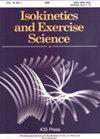振动泡沫滚动对跖屈肌最大等长收缩时爆发强度特性的急性影响
IF 0.7
4区 医学
Q4 ENGINEERING, BIOMEDICAL
引用次数: 0
摘要
背景:振动泡沫辊是一种新的发展,其实施尚未提供足够的科学依据。关于在强有力的肌肉活动之前实施振动泡沫滚动进行自我按摩是否是一种好策略的信息很少。目的:因此,本研究的目的是确定单次15秒和60秒振动泡沫滚动治疗对最大自主等长收缩(MVIC)期间肌肉收缩特性的急性影响。方法:20名健康且有娱乐活动的受试者参与本研究。在第一次访视期间,收集基线特征,而在第二次和第三次访视时,他们分别进行了15秒和60秒的振动泡沫滚动处理。使用跖屈肌的MVIC评估他们的最大力(F)max和力发展率(RFDmax)。结果:15秒和60秒治疗后,RFDmax受到负面影响(p⩽0.05),即使在恢复10分钟后仍保持下降。Fmax未观察到显著影响。结论:在实施振动泡沫滚动时,无论是作为锻炼前活动还是作为赛前治疗,都应谨慎。如果RFDmax对表现有显著影响,则应避免短期治疗。本文章由计算机程序翻译,如有差异,请以英文原文为准。
Acute effects of vibration foam rolling on the explosive strength properties of the plantarflexors during maximal isometric contraction
BACKGROUND: Foam roller with vibration is a recent development and its implementation has not yet been provided with a sufficient scientific justification. Information on whether an implementation of vibration foam rolling for self-massage before the powerful muscular activities is a good strategy is scarce. OBJECTIVE: Therefore, the aim of this study was to determine the acute effects of a single 15-s and 60-s vibrating foam rolling treatment on muscle contractile properties during maximal voluntary isometric contraction (MVIC). METHODS: Twenty healthy and recreationally active subjects participated in this study. During first visit, baseline characteristics were collected, while on the second and third visit they performed a 15-s and a 60-s vibration foam rolling treatment, respectively. Their maximal force (F)max and rate of force development (RFDmax) were assessed using the MVIC of plantarflexors. RESULTS: The RFDmax was negatively affected (p⩽ 0.05) after the 15-s treatment and 60-s treatment, staying reduced even after 10-min of recovery. No significant effects were observed for Fmax. CONCLUSIONS: When implementing vibration foam rolling, either as a pre-workout activity or as a pre-competition treatment, caution should be taken. Short duration treatment should be avoided for activities were RFDmax has a significant impact on performance.
求助全文
通过发布文献求助,成功后即可免费获取论文全文。
去求助
来源期刊

Isokinetics and Exercise Science
医学-工程:生物医学
CiteScore
1.20
自引率
14.30%
发文量
37
审稿时长
>12 weeks
期刊介绍:
Isokinetics and Exercise Science (IES) is an international journal devoted to the study of theoretical and applied aspects of human muscle performance. Since isokinetic dynamometry constitutes the major tool in this area, the journal takes a particular interest in exploring the considerable potential of this technology.
IES publishes studies associated with the methodology of muscle performance especially with respect to the issues of reproducibility and validity of testing, description of normal and pathological mechanical parameters which are derivable from muscle testing, applications in basic research topics such as motor learning paradigms and electromyography. The journal also publishes studies on applications in clinical settings and technical aspects of the various measurement systems employed in human muscle performance research.
The journal welcomes submissions in the form of research papers, reviews, case studies and technical reports from professionals in the fields of sports medicine, orthopaedic and neurological rehabilitation and exercise physiology.
 求助内容:
求助内容: 应助结果提醒方式:
应助结果提醒方式:


